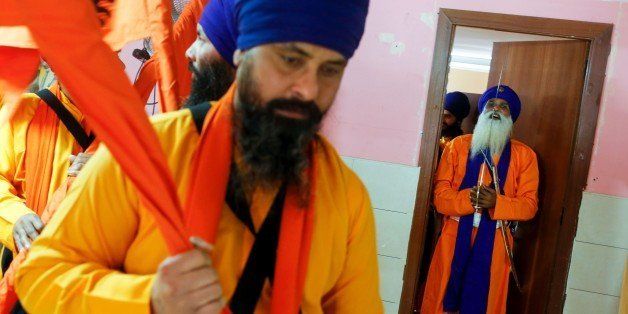
My favorite Vaisakhi happened when I was ten, when I watched my father walk down the streets of Madison Avenue in Manhattan, dressed in blue raiments with a striking orange turban alongside four other men dressed identically. He had been chosen to be one of the Panj Pyare or "Five Beloved Ones" during the annual Sikh Day Parade, celebrating Vaisakhi.
As I walked down each block alongside thousands of other Sikhs, I proudly waved a flag bearing an orange and blue Khanda, a Sikh symbol of political and spiritual freedom. Growing up a Sikh-American in post-9/11 New York City, I was used to facing prejudice because of my faith. My classmates would often tell me that my father looked like a terrorist because of his turban. It was empowering to see the parade celebrating Sikhism, and our belief in equality and respect for all.
Vaisakhi commemorates the formation of the Khalsa Panth, the community of all Sikhs, and their commitment to fighting discrimination. It also marks the formal passing of authority from the last living Sikh Guru onto our community as a whole.
On the day of Vaisakhi in 1699, Guru Gobind Singh, the tenth and last of the enlightened spiritual teachers and messengers of the developing Sikh faith (called Gurus), gathered Sikhs from across India to meet in the city of Anandpur Sahib, amidst political turmoil and under the oppressive rule of the Mughal Empire. As the Guru stood, he captured the attention of thousands of Sikhs, Hindus, and Shia Muslims in the crowd. After being massacred in large numbers because of their religious beliefs, the crowd stood united, trying to fight back, but on the brink of being forced to convert.
Guru Gobind Singh declared that it was the time to stand up for religious freedom. The Guru asked called for the heads of five Sikhs, a test to see who was willing to lay their life for the values of Sikhism. After a long silence, one by one, five volunteers approached him and he took them to the back of a tent, each time returning with a sword covered in blood. People began to think he had gone mad, and crowds began to disperse. It was then that the Guru presented the five volunteers to the crowd, unharmed.
He baptized them, the Panj Pyare, or Five Beloved Ones, for their fearlessness and commitment to the ideals of Sikhism. He declared that wherever the Panj Pyare were, so was the Guru. And he urged all Sikhs not only to fight for their own freedom but the freedom of others. In Sikhism every religion is respected, and what emerged from the Guru's call to action was a lineage of Sikhs willing to fight for a more inclusive future.
Guru Gobind Singh also created a unique identity for Sikhs, centering around five primary articles of faith: Kesh or unshorn hair, a Kangha or a short comb, a Kara or iron bracelet, a Kachhera or special type of boxer shorts, and a Kirpan or ceremonial short sword. Sikhs still adorn these articles of faith, although as a modern adaption, Kirpans are worn after being dulled and closed shut to the casing. This distinct identity was supposed to make Sikhs capable of being 'saint-soldiers.' This idea always resonated with me, because it meant being educated and compassionate but also willing to stand up to oppression even when it meant risking your own life.
Sikhism is now the fifth largest religion in the world with over 25 million adherents. And as the Sikh community grew, Sikhs found more ways to build the community that the Guru envisioned. A central concept to this community is seva, a term that describes selfless service and action, motivated by pure intentions, to help those around you.
I remember visiting the Gurdwara, or Sikh temple, in my own community, and going downstairs into the langar hall, a large kitchen where everyone sits on the floor as equals and is served free food. Seva has played an important role in helping me connect to people of different backgrounds because everyone is equal in the eyes of a Sikh. The concept of everything being God's creation is central to Sikhism.
We believe in one God, a Creator who permeates everyone and everything. We believe that all people have a divine quality and we should treat every person with respect. We are taught to earn an honest living and meditate on God's name ("Waheguru") as the path to becoming one with God. But being a recluse focused on prayer and devotion is insufficient. We're also trying to make our actions reflect our beliefs, by helping everyone we encounter, regardless of their background. Vaisakhi symbolizes the day Sikhs committed to upholding these values in our way of life.
Growing up in New York, I've seen how religious freedom in America has allowed the Sikh community to strengthen relationships within the faith and outside of it, even as prejudice persists. Vaisakhi epitomizes what I believe religion is meant to do: bring harmony amongst all groups of people. And in the spirit of Vaisakhi, I invite you all to celebrate with me on April 13th, 2016. Visit a local Gurdwara, ask questions, and experience langar firsthand. People of all faiths are welcome in the Gurdwara year-round, and I hope that this Vaisakhi opens up the doors for a future filled with more unity and understanding.